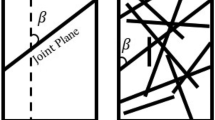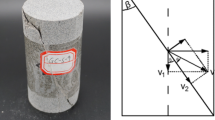Abstract
The stresses at the tips of the compressive-sheared cracks were calculated by applying the superposition principle. Then, the principal stresses at the tips of the compressive-shear crack were obtained. According to the Druker-Prager criterion, a fracture criterion for the compressive-shear crack, verified reasonable, was proposed. In addition, considering the influence of water, the above criterion was modified to investigate the influence of water on the stress intensity factors of cracks. The results show that the third principal stress of the main crack surface significantly increases the rock strength when the internal friction angle of the rock is lower than crack inclination angle. However, when the internal friction angle is higher than crack inclination angle, the increase of water pressure dramatically decreases the rock strength. When the internal friction angle is equal to crack inclination angle, the influences of water pressure and the third principal stress on the rock strength are the same. In addition, when crack inclination angle is lower than 30°, the third principal stress greatly influences the rock strength.







Similar content being viewed by others
References
Bidgoli MN, Jing L (2015) Water pressure effects on strength and deformability of fractured rocks under low confining pressures. Rock Mech Rock Eng 48:971–985
Chu CM, Ji YS (2017) Calculation on high rock slope strength parameter based on GSI. J Liaoning Tech Univ (Nat Sci) 36(5):488–493
Dai F, Wei MD, Xu NW, Ma Y, Yang DS (2015) Numerical assessment of the progressive rock fracture mechanism of cracked chevron notched Brazilian disc specimens. Rock Mech Rock Eng 48:463–479
Dai F, Xu Y, Zhao T, Xu NW, Liu Y (2016) Loading-rate-dependent progressive fracturing of cracked chevron-notched Brazilian disc specimens in split Hopkinson pressure bar tests. Int J Rock Mech Min Sci 88:49–60
Erdogan F, Sih GC (1963) On the crack extension in plates under plane loading and transverse shear. J Basic Eng 85(4):519-525
Gao W, Dai S, Xiao T, He TY (2017) Failure process of rock slopes with cracks based on the fracture mechanics method. Eng Geol 231:190–199
Guo SH, Sun ZQ, Xie XQ (2002) Research on mode and criterion of rock fracture under compressive loading. Chin J Geotech Eng 24:304–308
Huang YH, Yang SQ, Ranjith PG, Zhao J (2017) Strength failure behavior and crack evolution mechanism of granite containing pre-existing non-coplanar holes: Experimental study and particle flow modeling. Comput Geotech 88:182–198
Jiang GC, Hu NL, Hong GY, Li GQ, Fang JZ (2018) Determination of rock mass mechanical parameters based on quantification and correction method of GSI value. Rock Soil Mech 39(6):2211–2218 (in Chinese)
Liste JR, Kerr RC (1991) Fluid-mechanical models of crack propagation and their application to magma transport in dykes. J Geophys Res Solid Earth 96:10049–10077
Liu J, Li JL, Zhou JF, Chen PS, Chen XZ (2004) Research on relation of D-P failure criterion and rock fracture toughness K Ic, K IIc. Chin J Rock Mech Eng 23:4300–4302
Liu TY, Cao P, Lin H (2014) Damage and fracture evolution of hydraulic fracturing in compression-shear rock cracks. Theor Appl Fract Mech 74:55–63
Liu T, Lin BQ, Yang W (2017) Mechanical behavior and failure mechanism of pre-cracked specimen under uniaxial compression. Tectonophysics 712–713:330–343
Tang LS, Zhang PC, Wang Y (2004) On fracture strength of rocks with cracks under water action. Chin J Rock Mech Eng 23:3337–3341
Wang SY, Sloan SW, Sheng DC, Yang SQ, Tang CA (2014) Numerical study of failure behaviour of pre-cracked rock specimens under conventional triaxial compression. Int J Solids Struct 51:1132–1148
Wang YX, Guo PP, Ren WX, Yuan BX, Yuan HP, Cao P (2017) Laboratory investigation on strength characteristics of expansive soil treated with jute fiber reinforcement. Int J Geomech 17(11):04017101
Wang YX, Guo PP, Dai F, Li X, Zhao YL, Liu Y (2018) Behavior and modeling of fiber-reinforced clay under triaxial compression by combining the superposition method with the energy-based homogenization technique. Int J Geomech 18(12):04018172
Wang F, Cao P, Cao RH, Xiong XG, Hao J (2019) The influence of temperature and time on water–rock interactions based on the morphology of rock joint surfaces. Bull Eng Geol Environ 78(5):3385-3394
Wang YX, Guo PP, Li X, Lin H (2019a) Behavior of fiber-reinforced and lime-stabilized clayey soil in triaxial tests. Appl Sci-Basel 9(5):900
Wang YX, Shan SB, Zhang CS, Guo PP (2019b) Seismic response of tunnel lining structure in a thick expansive soil stratum. Tunn Undergr Space Technol 88:250–259
Wang YX, Lin H, Zhao YL, Li X, Guo PP, Liu Y (2019c) Analysis of fracturing characteristics of unconfined rock plate under edge on impact loading. Eur J Environ Civ Eng. https://doi.org/10.1080/19648189.2018.1509021
Wei MD, Dai F, Xu NW, Xu Y, Xia K (2015) Three-dimensional numerical evaluation of the progressive fracture mechanism of cracked chevron notched semi-circular bend rock specimens. Eng Fract Mech 134:286–303
Wei MD, Dai F, Xu NW, Zhao T (2016) Stress intensity factors and fracture process zones of ISRM-suggested chevron notched specimens for mode I fracture toughness testing of rocks. Eng Fract Mech 168:174–189
Wei MD, Dai F, Xu NW, Liu Y, Zhao T (2017) Fracture prediction of rocks under mode I and mode II loading using the generalized maximum tangential strain criterion. Eng Fract Mech 186:21–38
Wei MD, Dai F, Zhou JW, Liu Y, Luo J (2018) A further improved maximum tangential stress criterion for assessing mode I fracture of rocks considering non-singular stress terms of the Williams expansion. Rock Mech Rock Eng 51:3471–3488
Wong LNY, Maruvanchery V, Liu G (2015) Water effects on rock strength and stiffness degradation. Acta Geotech 11:1–25
Wu QH, Weng L, Zhao YL, Guo BH, Luo T (2019) On the tensile mechanical characteristics of fine-grained granite after heating/cooling treatments with different cooling rates. Eng Geol 253:94–110. https://doi.org/10.1016/j.enggeo.2019.03.014
Xu Y, Dai F, Xu NW, Zhao T (2016) Numerical investigation of dynamic rock fracture toughness determination using a semi-circular bend specimen in split Hopkinson pressure bar testing. Rock Mech Rock Eng 49:731–745
Xuan KJ, Zhang YS (2016) Determination of peak and residual strength of jointed rock masses based on GSI system. Site Investig Sci Technol 5:1–6
Yang SQ, Jiang YZ, Xu WY, Chen XQ (2008) Experimental investigation on strength and failure behavior of pre-cracked marble under conventional triaxial compression. Int J Solids Struct 45:4796–4819
Yu XZ, Qiao CX, Zhou QL (1991) Fracture mechanics of rock and concrete. Central South Industrial University Press
Zhang XN, Sheng ZP, Li X, Li SD, He JM (2011) Study of relationship between poisson’s ratio and angle of internal friction for rocks. Chin J Rock Mech Eng 30:2599–2609
Zhao YL, Zhang LY, Wang WJ, Pu CZ, Wan W, Tang JZ (2016) Cracking and stress–strain behavior of rock-like material containing two flaws under uniaxial compression. Rock Mech Rock Eng 49:2665–2687
Zhao YL, Zhang LY, Wang WJ, Tang JZ, Lin H, Wan W (2017a) Transient pulse test and morphological analysis of single rock fractures. Int J Rock Mech Min Sci 91:139–154
Zhao YL, Luo SL, Wang YX, Wang WJ, Zhang LY, Wan W (2017b) Numerical analysis of karst water inrush and a criterion for establishing the width of water-resistant rock pillars. Mine Water Environ 36:508–519
Zhao YL, Tang JZ, Chen Y, Zhang LY, Wang WJ, Wan W, Liao JP (2017c) Hydromechanical coupling tests for mechanical and permeability characteristics of fractured limestone in complete stress–strain process. Environ Earth Sci 76:1–18
Zhao YL, Wang YX, Wang WJ, Wan W, Tang JZ (2017d) Modeling of non-linear rheological behavior of hard rock using triaxial rheological experiment. Int J Rock Mech Min Sci 93:66–75
Zhao YL, Zhang LY, Wang WJ, Wan W, Li SQ, Ma WH, Wang YX (2017e) Creep Behavior of intact and cracked limestone under multi-level loading and unloading cycles. Rock Mech Rock Eng 50:1409–1424
Zhao YL, Zhang LY, ASCE M, Wang WJ, Wan W, Ma WH (2018) Separation of elastoviscoplastic strains of rock and a nonlinear creep model. Int J Geomech 18(04017129):1–18
Zhao YL, Wang YX, Wang WJ, Tang LM, Liu Q, Cheng GM (2019) Modeling of rheological fracture behavior of rock cracks subjected to hydraulic pressure and far field stresses. Theor Appl Fract Mech 101:59–66
Zhou JW, Xu WY, Shi C (2007) Investigation on compression-shear fracture criterion of rock based on failure criterion. Chin J Rock Mech Eng 26:1194–1201
Zuo JP, Li HT, Xie HP, Ju Y, Peng SP (2008) A nonlinear strength criterion for rock-like materials based on fracture mechanics. Int J Rock Mech Min Sci 45:594–599
Funding
This research is supported by the National Natural Science Foundation of China (51774131, 51774107), the Natural Science Foundation of Hunan province (2015JJ2067), the CRSRI Open Research Program (CKWV2017508/KY), and the Open Projects of State Key Laboratory of Coal Resources and Safe Mining, CUMT (SKLCRSM16KF12).
Author information
Authors and Affiliations
Corresponding author
Additional information
Editorial handling: Murat Karakus
Rights and permissions
About this article
Cite this article
Zhao, Y., Wang, Y. & Tang, L. The compressive-shear fracture strength of rock containing water based on Druker-Prager failure criterion. Arab J Geosci 12, 452 (2019). https://doi.org/10.1007/s12517-019-4628-1
Received:
Accepted:
Published:
DOI: https://doi.org/10.1007/s12517-019-4628-1




